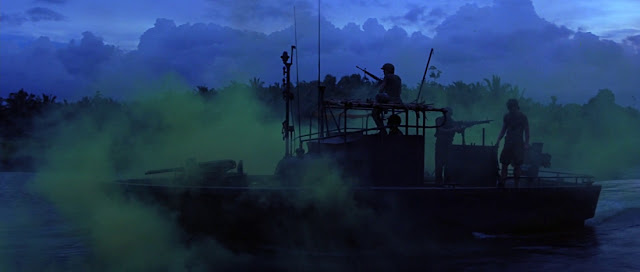Director: Francis Ford Coppola
DoP: Vittorio Storaro
Composer: Carmine & Francis Coppola
Ceremoniously saturated and strangely hallucinatory, Apocalypse Now subtly captures both the physical toll and the mental degradation of soldiers thrown into the violent light of established warzones. Cinematographer Vittorio Storaro utilises spectral imagery to illustrate the unconventionality of the Vietnam war. Perceptions of reality waver in mesmeric ways, the intense humidity traps the soldiers in a deep, idle haze as they travel through Vietnam to Cambodia, experiencing varying sights of air raids, the elaborate destruction caused by a napalm sortie, bridges under attack, a Playboy concert, tribes and villages alight and a Cambodian temple, inhabited by the worshippers of the US colonel, acting as a demigod. It is the feature's narrative arc which distinguishes its unique style, as the key characters of the feature are, for the large duration of the film, merely moving through the conflict.They are, like the audience, mere observers of the hellish landscape and are rarely ever directly involved in combat. Hence, a somewhat dream-like disconnect exists between the viewer and the violence. Striking visuals are accompanied by a stately pop and rock soundtrack with entries such as Shirley and Lee's 50s track "Let the Good Times Roll", The Rolling Stones "(I Can't Get No) Satisfaction" and the classic "Ride of the Valkyries" in the iconic napalm, air raid sequence. Apocalypse Now is a regal film, a hypnotic synchronisation of image and sound.



















































What a great movie this is. Certainly one of the greatest war pics ever made. Love all the stills you have, here.
ReplyDeleteThanks Wendell. It wasn't difficult. There's not a bad shot in this film.
Delete